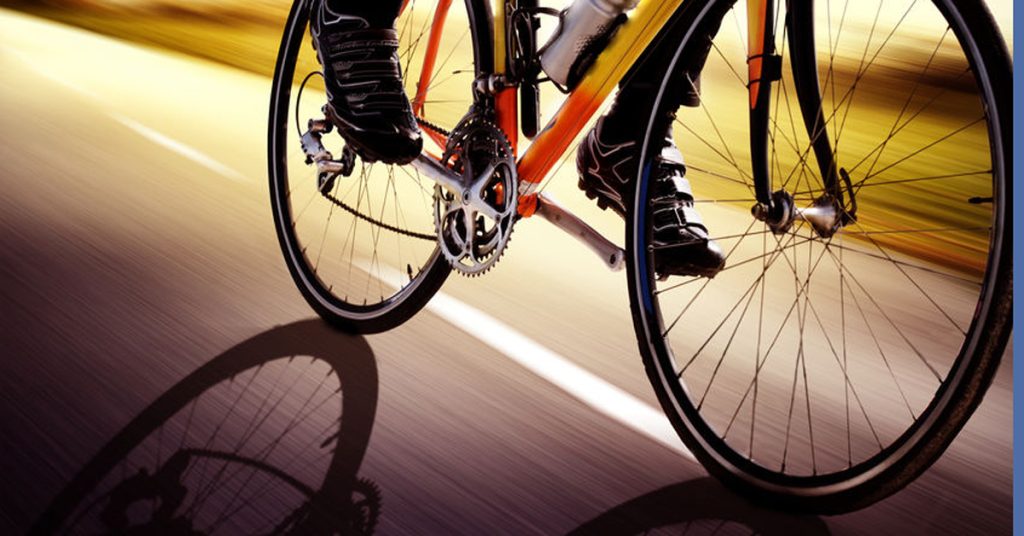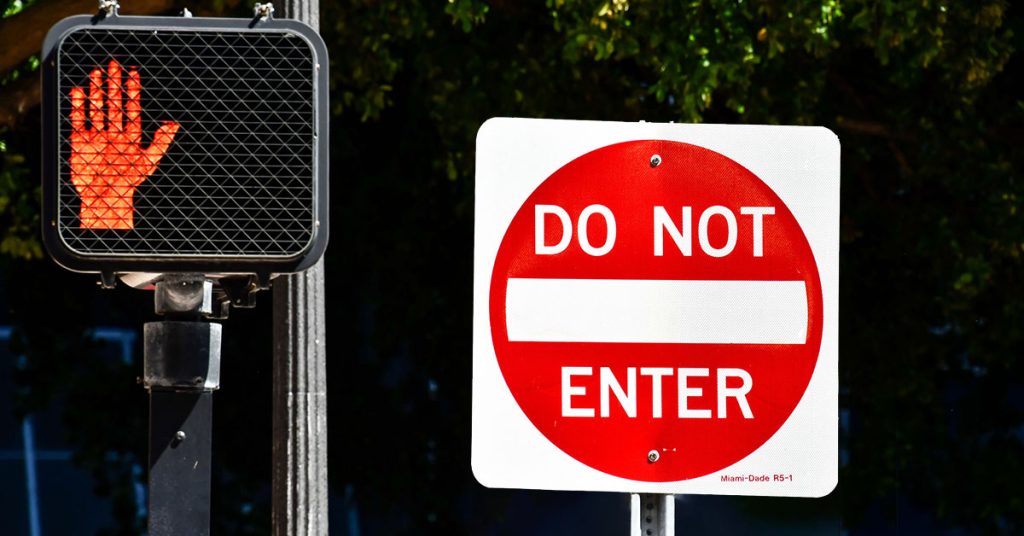Breakstone, White & Gluck Donates 100 Bicycle Helmets to Framingham Students Who Received New Bikes

Breakstone, White & Gluck recently had the opportunity to contribute to a very worthwhile bike safety donation with the Framingham Public Schools. With COVID-19 driving a space shortage on school buses, the school system decided to buy 100 bicycles to help middle school students who needed the most help getting to school.
If you ride a bike, you know you must wear a helmet to protect yourself against head injuries. Well, Breakstone, White & Gluck had helmets and we were pleased to donate 100 bicycle helmets to students as part of our Project KidSafe campaign.
This donation began with a school counselor who noticed a student did not have a bus seat and this was causing issues with their attendance. An assistant superintendent asked if other students were facing the same problem. The answer was yes.
The assistant superintendent looked to the community, which responded in a big way. The United Way of Tri-County and the Jewish Family Service of MetroWest agreed to split the cost of the bikes. The founders of 1854 Cycling Company founder and Crimson Bikes handled the challenging job of finding the bikes and helping the school negotiate a good price. As bikes were distributed at different schools, Framingham Police sent police officers to help fit the helmets. Another important aspect is Massachusetts Safe Routes to School is providing on-site training for the students, emphasizing the importance of wearing a helmet and using hand signals. As we mentioned, Breakstone, White & Gluck and our Project KidSafe donated the helmets. With so many community partners, we really enjoyed helping the students get started riding safely.
To learn more, read the Framingham Public Schools press release.
See the photos from the MetroWest Daily News.
Surprise! New Bicycle Helmets for Cyclists in Dedham Bike Maintenance Class
Surprise! Breakstone, White & Gluck gave away free Project KidSafe helmets to cyclists who signed up for the Basic Bike Maintenance Class at the Dedham Public Library earlier this month. Quincycles led the small class outside the library while Breakstone, White & Gluck was pleased to donate the bicycle helmets as part of our Project KidSafe campaign. Breakstone, White & Gluck first teamed up with Quincycles three years ago.
Quincycles does a great job of distributing a few helmets here and a few there to cyclists who attend its community classes, most of which are held in Quincy.


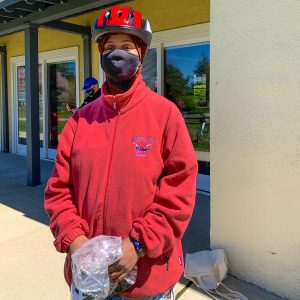
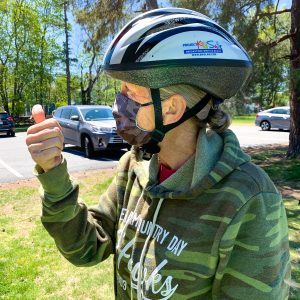
About Breakstone, White & Gluck and Our Project KidSafe Campaign
The attorneys of Breakstone, White & Gluck launched our Project KidSafe campaign in 2013 and have now given away more than 30,000 bicycle helmets in Boston, Cambridge, Somerville, Everett and across Massachusetts. We invite you to follow our 2021 donations at www.facebook.com/bwglaw.
Massachusetts Observes Motorcycle Safety Awareness Month With Caution As Fatal Crashes Rise

May is Motorcycle Safety Awareness Month. In Massachusetts, the message is critical as motorcycle fatalities are rising.
May is Motorcycle Safety Awareness Month and Massachusetts has to observe with more caution this year.
The number of fatal motorcycle crashes rose across the state last year. So did the number of fatal motor vehicle accidents, even as traffic volumes fell statewide with COVID-19. State officials say drivers were speeding down open roads and when accidents happened, they were more likely to be fatal.
Statewide, the number of motor vehicle fatalities increased more than 2 percent, from 336 deaths in 2019 to 345 deaths in 2020, according to MassDOT Crash Data as of May 10, 2021. While there were fewer pedestrian fatalities, the state saw a notable increase in both motorcycle and bike accident fatalities. Motorcycle fatalities increased 20 percent, from 48 fatalities in 2019 (including 46 motorcycle operators and 2 passengers) to 58 motorcycle fatalities last year (55 motorcyclists and 3 passengers). MassDOT also reported 10 fatal bicycle crashes last year, a 100 percent increase over 2019.
Because drivers traveled fewer miles last year, the traffic fatality rate climbed much more than the actual numbers across the country. At Breakstone, White & Gluck, we encourage drivers to refocus and work to travel safely near motorcyclists. We share these safety tips from the National Highway Traffic Safety Administration (NHTSA):
Motorcycle Safety Tips for Massachusetts Drivers
Motorcyclists Have the Same Rights. Drivers must share the road with motorcyclists. Motorcyclists have the right to travel in the traffic lane and even pass your vehicle, when it is safe to do so. They also have to obey the same traffic signs and signals. You can reduce the risk of causing a motorcycle accident by giving riders extra room and slowing down on your approach.
Recognize a Motorcycle’s Size. Appreciate the difference between a motorcycle and a motor vehicle. Motorcycles may weigh several hundred pounds. An SUV may weigh in at 5,000 to 6,000 pounds. Commercial vehicles carry many times this.
Use Your Mirrors and Look for Motorcyclists. Use your mirrors when you drive. Assume you will be sharing the road with motorcyclists, as well as cyclists and pedestrians.
Use Your Turn Signals. Activate your turn signal early enough so motorcyclists know you intend to turn.
Never Trust Motorcycle Blinkers. On the other hand, never trust a motorcyclist’s blinkers. Motorcycles may not have self-canceling turn signals. If a motorcyclist forgets to turn their signal off, it may continue blinking. When you approach an intersection and come up behind a motorcyclist, wait until you are certain of their plans to avoid causing a motorcycle turn collision.
Commit Not to Pick Up Your Cell Phone. By committing to this, you are in a better position to safely respond to motorcyclists and other traffic.
Safety Tips for Massachusetts Motorcyclists
If you are a motorcyclist, May is a good time to check in on safety fundamentals.
Check Your Helmet. The best way to protect yourself is to wear a motorcycle helmet. The NHTSA offers tips for choosing a motorcycle helmet.
Review Your Auto Insurance. Take a moment to review your auto insurance policy. Another driver may be responsible for your injuries. But the reality is many drivers operate illegally without auto insurance or only purchase the state’s minimum coverage requirements. It is important for you to consider this as you purchase auto insurance. Ask your auto insurance agent for help and read our article on optional auto insurance coverages for Massachusetts motorcyclists.
Sign Up for Motorcycle Training. The Registry of Motor Vehicles offers the Massachusetts Rider Education Program at motorcycle schools across the state. Training classes are designed for all skill levels. At training classes, you have the opportunity to learn and sharpen your skills. You may also qualify for a discount on your auto insurance, savings you can use to buy more coverage.
What to Do If You Are Injured in A Motorcycle Crash
When a driver hits a motorcyclist, victims usually suffer serious and life-threatening injuries. At Breakstone, White & Gluck, we understand a motorcycle crash is devastating and emotional. The motorcyclist, along with their family members, needs guidance from an experienced motorcycle accident lawyer. We have the experience you need at Breakstone, White & Gluck. Read about our past results for clients in motorcycle accident cases.
Contact Breakstone, White & Gluck for a free legal consultation to learn your rights. Our attorneys will review the facts of your case with you and explain if you have a potential claim against another driver. If you have been injured by a commercial truck, it is even more important to contact an experienced lawyer to oversee the full investigation from the start.
For a free legal consultation, contact our Boston motorcycle accident lawyers at 800-379-1244 or 617-723-7676. You can also use our contact form.
Massachusetts Cyclists May Finally Get Three Feet for Safety
 Cyclists may get a little more room for safety if lawmakers pass the road safety legislation Gov. Charlie Baker proposed this week.
Cyclists may get a little more room for safety if lawmakers pass the road safety legislation Gov. Charlie Baker proposed this week.
On Monday, the Baker-Polito administration filed an expansive road safety package, which among other changes, calls for a new primary seat belt law and a controversial measure allowing cities and towns to install red-light cameras.
One proposal – to be called Haley’s Law – seeks much steeper penalties for drivers who operate with a suspended license. Currently, drivers may face fines and/or up to 10 days in jail for the first offense in Massachusetts per M.G.L. c. 90, § 23.
With the new legislation, a driver who lets their license lapse, then drives could face up to $1,000 in fines and 5 years in prison for the first offense. Drivers who cause auto crashes resulting in serious injury could face up to 2 ½ years in a House of Correction. There would be a mandatory two-year sentence, and up to 10 years imprisonment, for drivers convicted in fatal crashes.
The legislation is called, “An Act Relative to Improving Safety on the Roads in the Commonwealth,” and was filed as Massachusetts re-opens after COVID-19. The pandemic changed everything on our roads. But despite lighter traffic, our roads were not safer last year.
According to state figures, Massachusetts saw 334 traffic fatalities during 2020, compared to 336 in 2019.
Safety Reforms for Massachusetts Cyclists
For cyclists, there are two significant proposals: a 3-foot safe passing distance and a truck sideguard mandate for all state-owned and operated trucks.
3-Foot Safe Passing Distance
When traveling near cyclists, the legislation would require drivers to maintain a three-foot safe passing distance and a safe and proper speed. Drivers would have the same responsibility near cyclists traveling without a protective barrier, such as a protected bike lane with flex posts. 36 other states have safe passing laws, according to the Baker-Polito administration. The proposed legislation would give both drivers and future road projects more direction on how to accommodate cyclists. Massachusetts lawmakers have not acted on similar legislation in previous sessions.
Most drivers know they must stay at least three feet away as a precaution to avoid bicycle crashes. But currently, Massachusetts traffic laws only recognize that drivers must pass cyclists at a “safe distance.” There is no consistent message on how much room to give cyclists.
Massachusetts traffic laws currently state in, “approaching or passing a person on a bicycle the operator of a motor vehicle shall slow down and pass at a safe distance and at a reasonable and proper speed.” M.G.L. c. 90 § 14. Drivers must “wait for a safe opportunity to overtake” a bicyclist or other vehicle, per M.G.L. c. 89 § 2.
Stronger Truck Safety Equipment Requirements
The Baker-Polito administration is calling for state-owned and operated trucks to utilize safety equipment such as sideguards, convex mirrors and cross-over mirrors. All these state vehicles weighing over 10,000 pounds would have to comply by Jan. 1, 2024.
The goal is to reduce the risk of injury and death to pedestrians and cyclists, the most likely victims in truck crashes, according to the Volpe National Transportation Center.
In Boston, we have seen numerous cyclists killed when truck drivers and companies are neglect to look. In 2014, the Boston City Council took strong action, passing the first-in-the-nation truck sideguard ordinance. All city-owned and city-contracted trucks must now be equipped with sideguards, convex mirrors, crossover mirrors and blind-spot awareness decals.
Today, as you drive through Boston, you will see large trucks with sideguards. But Boston – and Somerville and Cambridge have similar regulations – can only influence safety within the city. This is why many – including Breakstone, White & Gluck – support passing statewide legislation requiring sideguards protect cyclists and pedestrians from being swept under trucks. While this proposal would only impact state-owned and operated trucks, this could protect many cyclists and potentially encourage private industry.
Support Truck Sideguards in Massachusetts
MassBike is advocating for the passage of “An Act Relative to Improving Safety on the Roads in the Commonwealth,” which will protect cyclists on Massachusetts roads. If you support the organization’s work, visit the MassBike website and learn how to contact your local legislators and voice your support.
As Wrong-Way Crashes Rise, Drunk Driving is the Leading Cause, But a Driver’s Age and Driving Alone May Also Contribute
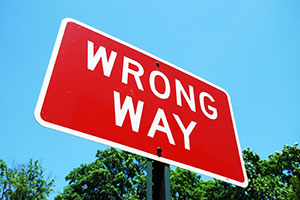
Wrong-way crashes are on a dangerous rise in Massachusetts and across the U.S., according to the AAA Foundation for Traffic Safety.
No one ever wants to hear the phrase “wrong-way crash.” But head-on collisions are frequent and often fatal on Massachusetts highways.
A new traffic analysis reveals the number of wrong-way crashes is rising on divided highways across the U.S. The majority of these auto crashes involve an alcohol-impaired operator. Drivers are exceeding the legal limit in 6 of 10 wrong-way car crashes, according to the AAA Foundation for Traffic Safety.
Drunk driving is the leading cause. Yet researchers say other factors, including a driver’s age and driving without a passenger, contribute. For example, 87 percent of wrong-way drivers travel alone. Passengers can be a resource for drivers, giving them an extra set of eyes to catch potential mistakes.
As for older drivers, those between 75 and 79 drive fewer miles and spend less time driving than younger operators. Still, they are more likely to be involved in a wrong-way crash and states are being urged to review how they identify medically at-risk drivers.
How Many Wrong-Way Crashes Are There in Massachusetts Each Year?
In Massachusetts, MassDOT data shows 150 people have died and more than 4,500 have been injured in wrong-way car accidents since 2010, according to CBSBoston.com. Since 2010, there have been 8,200 wrong-way crashes.
Nationwide, wrong-way accidents caused an average of approximately 500 deaths per year from 2015 – 2018, according to AAA. This represents a 34 percent increase from 2010 – 2014.
According to the CBSBoston.com report, the numbers also climbed in Massachusetts, from 19 to 27 deaths on average annually for the same period, a 78 percent increase.
Worcester recorded 366 wrong-way crashes, more than any other community in Massachusetts, followed by Springfield and Boston.
Wrong-Way Crashes Can Also Happen at Local Intersections
The AAA report focuses on wrong-way crashes on divided highways. Drivers can also make dangerous maneuvers resulting in wrong-way accidents at local intersections. From 2015-2018, the Federal Highway Administration reported roughly 400-450 wrong-way crashes at intersections.
Crashes may not be reported the same way at intersections, which have different traffic conditions, speeds and signage. When there is a wrong-way crash, the driver may be cited for another infraction, such as a marked lanes violation or failure to stop for a traffic signal.
But if you have been seriously injured at an intersection with a “Do Not Enter-Wrong Way” sign, it is in your best interest to consult an experienced car accident attorney who can thoroughly investigate the cause of a collision and your injury. An attorney can help you secure evidence promptly and with every aspect of your claim should you need to seek compensation from an at-fault driver’s insurance policy.
Strengthening Traffic Laws to Reduce Wrong-Way Crashes
The AAA Foundation for Traffic Safety and the National Transportation Safety Board are working to educate drivers about taking safety precautions to avoid wrong-way crashes and head-on traffic crashes. The most fundamental step is not to drink and drive.
The organizations also support passage of safety laws and infrastructure improvements, including more visible traffic signs.
Ignition-interlock laws are part of this effort and all eyes are on Massachusetts. We are the only state which does not require drivers with a first-time OUI conviction to utilize ignition interlocks, which test one’s blood alcohol concentration before they start driving.
However, after years of unsuccessful debate, Massachusetts may finally be moving closer. Last December, Gov. Charlie Baker signed an amendment to the state budget which if passed, will make ignition interlocks mandatory for all drivers convicted of operating under the influence. This could make a meaningful difference in discouraging choices that lead to drunk driving crashes and very serious injuries across Massachusetts.
Tips for Driving Safely on Highways
Do Not Drink and Drive. Never consume alcohol – or marijuana or other drugs – then drive. Use the designated driver system if you plan to go out and consume alcohol. Drivers have the same responsibility when using prescription medications which carry safety warnings about driving. If you have a question, consult your doctor on when and how you should use your medication.
Stay Alert. Do not drive if you are drowsy or fatigued. If you find yourself too tired to drive, stop your vehicle and come up with a short-term plan for getting some rest or grabbing a cup of coffee. There is always an alternative, including Uber or Lyft. Drivers often want just to push through and reach their destination. But if your vision is blurry or you cannot focus, you are driving negligently and putting others in harm’s way.
Drive with a Friend. You can split up the driving responsibilities, which will reduce your fatigue.
Avoid Distracted Driving. Reaching for a cell phone is the cause of many auto accidents. You are not using reasonable care to drive safely if you attempt to make a phone call while traveling through highway traffic, among other cars, SUVs and large trucks.
While Massachusetts has a hands-free driving law and drivers are legally allowed to make phone calls with Bluetooth devices, the safest approach is to still look for a rest stop or exit and safely park your vehicle before using your phone.
Create a Family Support System. Families can support each other in getting home safely. Try to develop a network of friends and loved ones who will support you. Ask them in advance if they would be willing to come pick you up if you ever needed a ride. Be willing to do the same for them.
Help Older Drivers Plan. Be proactive. Take time to discuss transportation options with the older driver in your life. If they drive, help them plan the best times of day to travel and steer them away from the highway. Remind them the importance of having a regular eye exam.
Let them know they have support. Make a schedule for your loved one to get out several times a week with you, other family members, grandchildren or a Council on Aging.
Free Legal Consultation – Call Our Boston Auto Accident Lawyers
With more than 100 years combined experience, Breakstone, White & Gluck specializes in representing those who have suffered serious personal injury or wrongful death due to negligence. We are based at 2 Central Plaza in downtown Boston.
With expertise in Massachusetts insurance laws and traffic accident investigations, our attorneys are here to guide clients through the difficulties you face after a serious accident. For a free legal consultation, contact Breakstone, White & Gluck and our car accident lawyers at 800-379-1244 or 617-723-7676 or use our contact form.
Sharp Rise in Pedestrian Fatality Rate During the First Half of 2020, Despite COVID-19 Restrictions
 Less traffic did not mean fewer pedestrian accidents in the early months of the pandemic. In fact, preliminary traffic data shows there was roughly the same number of fatal pedestrian accidents in the first half of 2020 compared to the same period of 2019.
Less traffic did not mean fewer pedestrian accidents in the early months of the pandemic. In fact, preliminary traffic data shows there was roughly the same number of fatal pedestrian accidents in the first half of 2020 compared to the same period of 2019.
However, because there were fewer cars out, the Governor’s Highway Safety Association (GHSA) is actually projecting a 20 percent increase in the pedestrian fatality rate per one billion miles traveled, according to the report, “Pedestrian Traffic Fatalities by State: 2020 Preliminary Data.”
According to the data analysis, 2,957 pedestrians were killed in motor vehicle crashes during the first half of 2020. This is 6 more pedestrians than the same period of 2019, when the calculation included more vehicles on the road.
If trends continue, 2020 could end up having a record rate of fatal pedestrian accidents, despite having fewer cars on the road.
How much less traffic? The Federal Highway Work Administration reported a 16.5 percent decrease in traffic on all roads and streets in 2020. Here in Massachusetts, MassDOT reported an immediate 50 percent reduction in traffic volumes in April 2020. Massachusetts traffic volumes were still 20 percent lower than normal in September 2020, according to our past blog on COVID-19 traffic conditions in Massachusetts.
Larger Trend of Pedestrian Fatalities
For years, pedestrian fatalities have been on a dangerous rise in the U.S. Prior to COVID-19, pedestrian traffic fatalities stood at the highest levels since 1990. There was a striking 46 percent increase in these accidents from 2010 to 2019, according to the GHSA. In 2019, pedestrian traffic fatalities accounted for roughly 17 percent of all traffic deaths.
How Many Pedestrian Fatalities Occurred in Massachusetts During COVID-19 in 2020?
In preliminary data, Massachusetts reported 17 pedestrian fatalities in the first half of 2020, compared to 32 from January to June 2019.
Massachusetts was one of 20 states, along with Washington D.C., which reported a decrease in the actual number of pedestrians who were killed in car accidents or crashes involving trucks, SUVs and other vehicles.
In 27 other states, the number of pedestrian fatalities in car accidents and truck crashes increased.
Notably, more than half of all pedestrian fatalities happened in seven of the most populous states, including Arizona, California, Florida, Georgia, New York, North Carolina and Texas.
Contributing Factors in the Rising Number of Pedestrian Fatalities
The GHSA cited several trends in these fatalities, including drivers who sped down open roads simply because there was less traffic.
Distraction and fatigue also contributed to many pedestrian crashes, including when drivers were negligent and failed to stop at an intersection or stay within the marked lane. In Massachusetts, the new hands-free cell phone law took effect in April 2020 but the impact was effectively delayed by Covid-19.
In addition, the report touched on the trend of drivers choosing light trucks and SUVs more often. In 2019, sales of light trucks and SUVs far outpaced passenger vehicles. The larger vehicles accounted for 72 percent of all auto sales.
Pedestrians are still more likely to be injured by a driver in a passenger car. However, over the past 10 years, there has been a 69 percent increase in SUV accidents resulting in pedestrian fatalities.
With larger frames, SUVs have a unique front-end design which is particularly threatening to pedestrians. In a pedestrian SUV crash, the grill can strike a pedestrian’s pelvis or chest at nearly the same time the vehicle’s bumper hits the lower extremities, increasing the force of the impact.
Free Legal Consultation – Boston Pedestrian Accident Attorneys
At Breakstone, White & Gluck, our pedestrian accident lawyers are committed to fighting for the rights of those injured or killed by a driver’s negligence or wrongdoing. We have represented clients after pedestrian accidents in Boston, Cambridge and throughout Massachusetts. Our attorneys have recovered significant awards, including:
- $7.1 million for our client was who hit by an MBTA bus in a South Boston crosswalk
- $2.15 million for the estate of our client who was hit and killed in a parking lot, which was not equipped with pedestrian safety bollards
- $1.375 million for our client who was hit by a speeding MBTA bus in Roxbury
If you or a family member has been injured in a pedestrian crash, learn your legal rights. For a free legal consultation, contact Breakstone, White & Gluck at 800-379-1244 or 617-723-7676 or use our contact form.
Child’s Death on Peloton Treadmill Prompts New Safety Warnings

While convenient for parents, at-home treadmills, stationary bikes and fitness equipment can cause children serious injuries.
If you have jumped on the Peloton bandwagon, you are not alone. But many parents are exercising with more caution this week after learning about a child’s tragic death on a Peloton treadmill. Consumers are being urged to keep children away from the fitness equipment, as the Consumer Product Safety Commission (CPSC) investigates.
Peloton Interactive, Inc. became a household name during the 2019 holiday season, with a tongue-in-cheek ad campaign that poked fun at a husband and his “Peloton wife.” Then the pandemic began and Peloton became the fast rising star of the fitness industry. Many rushed to set up a high-end stationary bike or treadmill right at home, then logged into the fun digital app.
Peloton’s CEO announced the child’s death on a Tread+ last week in a letter, revealing the company was also aware of a small handful of other Tread+ accidents involving children. While he cited no injuries in these cases, NBC later reported that another child, a 3-year-old boy, had suffered serious injuries after being found trapped under a Peloton Tread+.
According to SaferProducts.gov, the child’s father had found the boy trapped under a Peloton Tread+ in early February. Initially, he was not breathing and had no pulse. The boy suffered a significant brain injury, along with a neck injury and petechiae on his face, which can occur when one’s blood flow is blocked. Peloton learned about the incident from the CPSC and said the company’s heart went out to the family.
If you or your child has been injured by an unsafe product, you should receive immediate medical care and report your injury promptly to help warn others. You do not have to make a report on your own. Report the incident with guidance from an experienced product liability lawyer at Breakstone, White & Gluck, who can advise you of your legal rights.
Treadmill Injuries
This is a timely investigation and conversation. Many families have purchased fitness equipment to use from the convenience of their homes as they juggle family and work responsibilities under COVID-19 restrictions. As a result, treadmill sales rose over 120 percent between March and October 2020, according to the Washington Post. Stationary bike sales nearly tripled.
Treadmills, though a convenient way to exercise from your home and office, are associated with many fitness equipment injuries. Across the country, emergency rooms treated an estimated 22,500 treadmill-related injuries during 2019, according to the CPSC. Children under 8 suffered about 2,000 injuries. There were 17 fatal injuries on treadmills between 2018 and 2020, including a 5-year-old girl.
Using Treadmills Safely in Your Home
According to Consumer Reports, children ages 1 to 6 suffer the most treadmill injuries of any age. Older siblings can also be injured when they just want to try the equipment and interactive features that look like video games.
Consider that young children are often just learning how to ride their first bike and developing their coordination skills. They are not strong enough to use a heavy, mechanical piece of equipment, not even for just a moment under an adult’s supervision.
Treadmill companies have a duty to warn consumers about the potential harm to children and how to prevent injuries to children. Manufacturers also have to watch how they showcase fitness equipment in ads and commercials. If a consumer sees a bike set up in a living room or family space, this may leave the impression that this is safe near children and families.
You can take steps to protect your children by securing fitness equipment in a separate room, away from your children and pets. Just as important, remove the safety key when you are done using the treadmill and fold it up if possible.
Mechanical Defects and Other Issues with Treadmills
When you buy fitness equipment, you may wonder whether you will enjoy using it or if it will be worth the investment. No one expects to be injured or see their child injured.
Yet there are many defective and unsafe products sold each year. This includes defective equipment which should have never been sold due to defective design or manufacturing error. Injuries can also happen when a manufacturer fails to warn the consumer about unsafe use. Manufacturers have a duty to promptly report when their products cause injury or wrongful death.
Many treadmill injuries can be traced back to poor manufacturing. Consumers have no warning about mechanical problems, such as spinning belts and erratic motors, until they use the machines. As a result, a consumer can lose their stop or fall, first hitting a moving treadmill and suffering head injuries or skin lacerations.
Improper set up can also contribute to injuries. Treadmills should come with instructions on where to safely place the equipment in your home or office. When a user misses a step, they are much more likely to get caught in the tread mat or hit a wall if they do not have adequate space. Read the instructions carefully as treadmills can come in different weights and sizes at times. As a guide, consider the ASTM International treadmill recommendations are to leave at least 6 1/2 feet of free space behind the treadmill. There should be about 1 ½ feet on each side. But your model may have different specifications.
Incomplete or incorrect labeling is another source for fitness equipment injuries. Without proper warning, the consumer cannot make the best decision about whether the product is safe for purchase and use in their home environment.
In addition to larger fitness equipment, be aware of small accessory equipment. Weights, air-filled exercise balls and yoga straps all look simple to use. But these fitness products can be poorly made with cheap materials, making them unsafe for both children and adults.
In one recent case, one of our attorneys led an investigation and negotiations which resulted in a $1.15 million product liability settlement for our client.
Free Legal Consultation – Boston Defective Product Attorneys
Breakstone, White & Gluck of Boston is committed to providing our clients with aggressive and thorough representation. If you or someone in your family has been injured by an unsafe product, contact our product liability lawyers. We serve clients across Massachusetts, including in Boston, Cambridge, Waltham, Framingham, the North and South Shores, Cape Cod, Fall River and Worcester. For a free consultation, call 800-379-1244 or 617-723-7676 or use our contact form.
Breakstone, White & Gluck Donates Bicycle Helmets for a Special Brockton Police Safety Event
 Breakstone, White & Gluck was so pleased to support a family event hosted by the Brockton Police Department and other community partners this past weekend. This was a special event because Brockton Police gave away both free car seats and bicycle helmets to local children and families. The goal was to prevent injuries. Many families struggle to get started with car seats and bicycle helmets and end up using them improperly.
Breakstone, White & Gluck was so pleased to support a family event hosted by the Brockton Police Department and other community partners this past weekend. This was a special event because Brockton Police gave away both free car seats and bicycle helmets to local children and families. The goal was to prevent injuries. Many families struggle to get started with car seats and bicycle helmets and end up using them improperly.
The Brockton Police Department partnered with Copeland Toyota and Buckle Up for Life to give families free car seats. Brockton Police has four officers who are certified child passenger safety technicians. They can speak English, Spanish, Cape Verdean Creole and Hatian Creole. Especially after the pandemic, this event was a good opportunity for parents and caregivers to receive a free car seat, have it installed by a police officer and ask questions.
Breakstone, White & Gluck donated the children’s bicycle helmets from our Project KidSafe campaign. Brockton Police helped the children fit their new helmets.
Photo: From left to right, Shahzad Shahab, general manager of Copeland Toyota, then Maria Rivas and her son wearing a Project KidSafe helmet. Center is Brockton Police Chief Emmaneul Gomes, then Lt. Brenda Perez and Brockton Mayor Robert Sullivan on the right.
Brain Injury Awareness Month: Simple Steps You Can Take to Protect Your Children
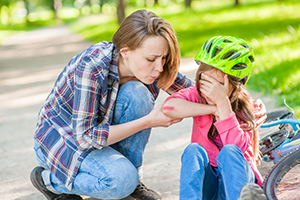
March is Brain Injury Awareness Month, a good time to ask if you or your children need a new bicycle helmet.
Each March, the Centers for Disease Control and Prevention (CDC) observes Brain Injury Awareness Month to highlight new research on injury prevention.
This is a good time for parents to reflect upon what you can do to protect yourselves and your children from a concussion. To start, you can purchase a bicycle helmet for your child and buckle them up in an age-appropriate car seat. Before you sign up for youth sports, really learn about the activity and consult your child’s pediatrician. The CDC recently shared this study, which suggests non-contact or flag football programs may be safer for children under 14 because there are fewer head impacts.
You can also commit to learn how to recognize the symptoms of a concussion so you can properly respond and seek medical attention for your child. This is an ongoing learning process which gets stronger, through conversation with your pediatrician, your child’s school and with your own family members.
Wear a Helmet. In Massachusetts, your child is required to wear a protective helmet while riding a bicycle or scooter. Read our blog, “How to Fit a Bicycle Helmet.” We also share some resources on Massachusetts helmet laws at the bottom of this webpage.
Massachusetts Concussion Protocol for Students. Before each season, your child’s middle or high school has a responsibility to share information about the Massachusetts youth sports concussion law with you.
Massachusetts law requires schools to develop concussion safety programs and provide training for students, parents, coaches and others on how to identify concussion symptoms. Schools must also explain the protocol for removing a student who has been injured from play.
Students suspected of having a concussion must see a doctor and must receive a doctor’s note before returning to practice or a game. It is essential to understand just how your school or coach will communicate with you.
No one ever wants to think about their child possibly suffering an injury. But the state protocol is largely about taking steps to prevent an injury and how to identify potential injuries. This is essential reading that will help you protect your child. Take time to read if even if you have already seen these materials in the past. Also take time to share and discuss this information with your spouse, baby sister or family members who care for your child.
Learn more about the Massachusetts concussion guidelines for student athletes and the CDC’s Heads Up Concussion page.
Commit to Watch for Symptoms. There are some situations when it is clear a parent should seek medical attention for their child. For instance, if your child’s school alerts you or if your child was injured in a car accident, those are your warnings.
However, the symptoms of a concussion may be less clear when children are injured while playing at home or other situations. To help you learn the signs, we have compiled a list of physical, emotional and sleep-related symptoms which may indicate you should contact your child’s pediatrician on our concussion webpage. These are compiled from the CDC web page on concussion symptoms.
Please consider the symptoms collectively, along with your child’s recent activities on the sports field or playing at home or with friends. If you have reason for concern, make the decision to contact your child’s pediatrician or visit the emergency room.
Free Legal Consultation – Boston Personal Injury Lawyers
At Breakstone, White & Gluck, our personal injury lawyers have extensive experience representing those who have suffered concussions, second-impact concussions and brain injuries. Over the past three decades, our attorneys have counseled and guided many clients to the financial results they need to recover from these complex injuries. For a free legal consultation, contact us at 800-379-1244 or 617-723-7676.
In addition to our work, Breakstone, White & Gluck works to help children and families protect against head injuries through our Project KidSafe campaign. We have proudly given away more than 30,000 bicycle helmets to children across Massachusetts.
Children Have Suffered More Dog Bite Injuries During Pandemic
 Research published in the Journal of Pediatrics reports a 3x increase in children seeking care for dog bite injuries at a Colorado hospital during the pandemic. The researchers noted that this trend likely spread beyond this one hospital.
Research published in the Journal of Pediatrics reports a 3x increase in children seeking care for dog bite injuries at a Colorado hospital during the pandemic. The researchers noted that this trend likely spread beyond this one hospital.
In January 2019, the hospital reported 3 dog bite injuries per 1,000 ER visits. Over April and May of 2019, the rate increased. In July 2019, the rate reached a peak of 7 dog bite injuries per 1,000 ER visits.
Fast forward to January 2020, which also saw 3 dog bite injuries per 1,000 ER visits – same as the previous January. By May 2020, there were about 13 dog bite injuries per 1,000 ER visits. Dog bite injuries continued to rise after Colorado lifted its stay-at-home order that April.
A New York Times article attributed the rise in part to so-called pandemic puppies. Owners may not have planned to bring these pets home during 2020. In some cases, these were complete impulse decisions. Who expected to be home this long? Because of that, owners may not have been prepared to train and care for puppies. There was also decreased access to dog trainers.
Children had increased exposure to puppies during those shelter in place days. Children usually have more contact with dogs when finish school for the summer. Here, children began spending more time with dogs in March of 2020. As children stayed home, parents struggled to balance home-schooling and their own jobs and may not have been supervising children near dogs as closely.
Dog bites are traumatic and can be life-threatening for young children. At Breakstone, White & Gluck, our personal injury lawyers know no one completely realizes how vicious a dog can be when it attacks. Training a dog is one step to help prevent a dog attack. Just as important is keeping a dog on a leash at all times. You never know what may trigger your dog to bite or attack. Even well behaved and calm dogs have unexpectedly attacked young children. One incident can be all it takes to change a child’s life forever.
A 2020 study shows just how important it is for parents or relatives to factor in a child’s age when bringing home a dog. Children under 11 were three times more likely than older children to be admitted to the hospital, according to the study, which was authored by a physician at UMass Memorial Medical School in Worcester. Younger children were also more likely to be admitted to the hospital.
Children age 1 through 10 were more likely to suffer open wounds to the head, neck and lower body. The study reviewed more than 6,300 hospital admissions from the Kids’ Inpatient Database during 2006, 2009 and 2012. One third of the patients had injuries so severe they required surgery.
Tips to Keep a Safe Dog After COVID-19
If you have a dog, we suggest the following tips to protect your children, family and neighbors from a dog bite injury:
- Always keep your dog leashed and under control when you are outside your home.
- Continue to limit guests to your home as COVID-19 restrictions get lifted.
- Secure your dog when guests come over.
- Do not leave your dog alone with your children or other children.
- Be aware that younger children have a higher likelihood of injury to their neck or head.
- Also be aware that many children suffer dog bites from their family pet or from pets they know well.
- Train your dog and socialize them.
- Consult your veterinarian or a dog trainer.
- Walk your dog outside on a leash a few times a day so it can get some exercise.
- Give your dog some personal attention each day.
- Recognize that dogs may be more likely to bite when they are gathering or protecting belongings. This is called “resource guarding.”
- Build a fence.
If you brought home a pandemic puppy, you have some planning to do since your dog has limited exposure to other people. Keep your dog on a leash when outside or when you have guests over. With all dogs, it is critical to ease your dog back into the social experience of being around guests at your home, including close friends and extended family members.
Building a fence in your backyard may also be a good spring project. A fence keeps your dog out of sight from your neighbors and their children. When children see a dog, they are more likely to want to approach and pet it. But as a dog owner, you must remember it’s devastating for a child to suffer a dog bite injury. The law on liability is also strict in Massachusetts. You can be held liable if your dog bites a young child, even if the child went onto your property without permission. The law recognizes that young children may not realize they are stepping toward danger. Your dog doesn’t have to have a history of dog bites or attacks for you to be held liable.
Free Legal Consultation – Boston Dog Bite Attorneys
If you have been injured by a dog or want to learn more about Massachusetts law concerning a dog owner’s responsibilities, visit our website. Each of our partners has more than 30 years of experience representing children and others injured by dog bites and dog attacks. We are here to advise you on your rights for seeking compensation for your child or yourself.
For a free legal consultation, contact our dog bite lawyers at 800-379-1244 or 617-723-7676 or use our contact form.





